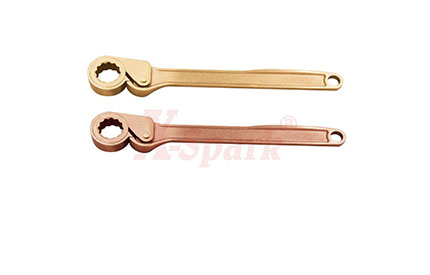The non-sparking safety tool is a special safety tool, which has the characteristic of not generating sparks when the tool collides with the workpiece or friction.
Most varieties and specifications are evolved from steel tools, but they are made of multi-element non-ferrous metals with copper as the base material. Some products are specially designed.
Therefore, there are certain requirements for use, maintenance, storage, and transportation.
Only by fully understanding, choosing reasonably, using, and keeping it correctly, can it give full play to its various performance advantages.
Therefore, users should strictly observe the following precautions.
(1) Non-sparking safety tools are a kind of safety protection products, so users must purchase products that have passed the inspection and appraisal of the nationally recognized explosion-proof performance test unit.
When purchasing, you must carefully understand the scope of adaptation, performance, characteristics, use methods, and precautions specified in the manual.
In addition, the tool body is usually marked with an "Ex" mark, and it has a certificate.
Unmarked tools cannot be purchased and used casually.
(2) Before using non-sparking tools, the combustible gas in the workplace should be compared with the explosion-proof test gas; products that have passed the test with a higher level of media can be used in places with lower hazardous levels.
Conversely, products that have passed the tests of lower-level media cannot be used in places with higher levels of danger. In the case of special needs, please ask the manufacturer to go to the testing unit to pass the test before using it.
Obviously, it should not be used arbitrarily as a common tool in non-hazardous places, so as not to lose its due performance.
It should be pointed out that it should not be substituted randomly. If the specifications of the current production varieties cannot meet the needs of users, special design and manufacturing should be applied.
(3) The explosion-proof medium is high-strength and corrosion-resistant in most medium gases. Such as a non-sparking wrench.
However, it is not corrosion resistant under all conditions. For example, it is corroded in wet ammonia, certain ammonium salts, acetylene, wet fluorine, chlorine, chromium ammonium, some dichromates, potassium hydride, and other media. The degree is quite large.
In addition, some media will undergo chemical reactions after contact with copper alloys, generating dangerous explosive substances, such as acetylene steel formed by the combination of acetylene and steel.
For this reason, when using non-sparking safety tools, try to use them in a dry environment as much as possible. If it is impossible to avoid using them in a humid environment, speed up the operation as much as possible, and reduce the working time to avoid causing greater corrosion and danger.
Wipe clean at any time after use, and it is strictly forbidden to store it together with corrosive media.
(4) The various wrenches of non-sparking safety tools have different rated strengths. It is strictly forbidden to use casing with overload. No knocking is allowed except for knocking wrenches, so as to avoid breaking and deformation due to overloading and affecting normal use.
In the process of using tools, you should choose their varieties and specifications reasonably according to your needs. Do not use small ones to replace large ones, let alone treat them as steel tools. It should also be pointed out that when using adjustable wrenches, pipe wrenches, and open wrenches, Pay attention to the requirements of the direction of the force, and do not use any reverse force. When using a tool with a blade, the hardness of the workpiece itself should be measured first. If the hardness is close to the hardness of the tool, it should be carefully operated. If the hardness is higher than the hardness of the tool, it is prohibited.
When the workpiece is tightened by motor, semi-permanently fixed, or due to long-term corrosion, and no other measures are taken before using the hand tool, it should be prohibited to use it to avoid damage to the tool.
(5) After stopping the non-sparking safety tools, they should be wiped clean at any time. Those don't in use within half a year should be oiled or preserved with the anti-corrosion method, and those that are not used for more than one year should be oiled and stored in a bag or box.

Naturally, some parts of used tools are worn or damaged, especially tools with blades. It can be repaired in a non-hazardous area.
If it is severely damaged and worn and it is not suitable to repair it by yourself, it should be scrapped.
评论
发表评论